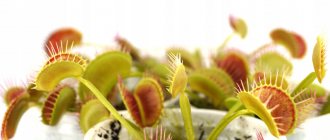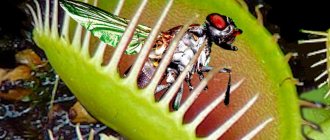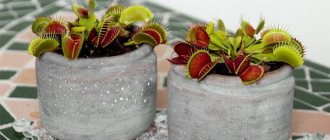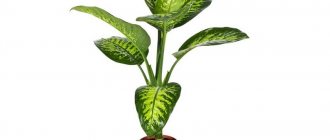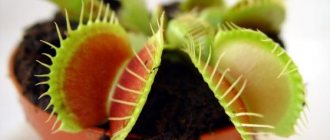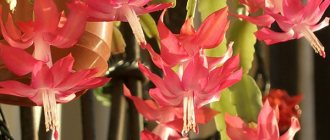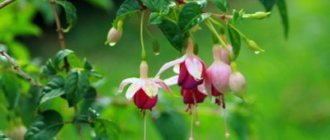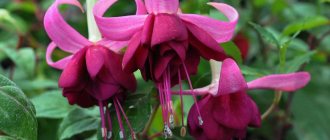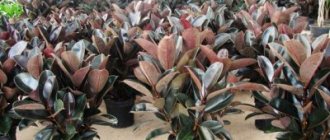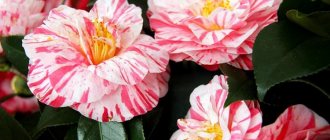An inhabitant of the wetlands (savannas) of the east coast of the United States, the Venus flytrap can successfully settle in your home on the windowsill if you like original and somewhat capricious guests. We are sure that you will be interested in watching how the flower grows, how it blooms and, finally, how it catches insects for lunch. In this article we will tell you how to feed a Venus flytrap at home.
general description
Under natural conditions, the flycatcher is found in the eastern United States of America, in pine forests in the middle of peat bogs.
It prefers to grow in a humid temperate climate, near the Pacific coast.
The soil in this region has few nutrients, so Dionea adapted in her own way to the proposed living conditions, learning to hunt insects and extract the necessary components from them.
Venus is a low plant (in natural conditions - twenty centimeters in height, in apartments - ten - twelve ). It has four to seven leaves growing from a small underground stem, invisible to the eye.
The long leaves consist of two parts. The lower green part of the leaf feeds on light, and the upper trap provides living food. It consists of two slamming doors with sharp teeth on the edges of each. Inside each valve you can find three setae, as well as scarlet glands that produce insect-dissolving liquid.
The appearance of the plant depends on the time of year: in summer, the traps become large and are painted a bright burgundy color. This is necessary to attract potential victims; insects, seeing the red color, think that the plant has nectar and fall into a trap.
In winter, the predatory flower is in a calm state, so the traps die off, and it seems that the plant has dried up and died.
REFERENCE! The mechanism of eating insects is worthy of attention, although it is quite creepy to watch.
To attract prey, Venus secretes fragrant nectar. When an insect descends into the trap, it touches one of the three bristles. The mechanism does not work immediately, this is a kind of protection against the empty slamming of the doors if, for example, a speck gets into them.
When the insect touches the bristles for the second time, the trap slams loosely, and when it touches the bristles for the third time, it closes completely, not giving the victim any chance of freedom. After this, digestive juice is released, which dissolves the insect within one to three weeks.
IMPORTANT! The stronger and more active the insect tries to get out, the tighter the Venus flytrap will squeeze the death trap.
In late spring and early summer, Dionea blooms with gorgeous snow-white flowers.
A Venus flytrap can live up to twenty years , functioning well.
Compression phase
If the initial slam of the trap is successful, the compression phase begins, which lasts about half an hour. The process looks like this. During the struggle, the insect inside the trap continues to touch the “trigger hairs.” This signals the flycatcher that it needs to further clamp the flaps to keep the victim inside. If the insect is small enough, it can slip through the teeth of the trap and escape.
The compression phase does not occur if the slamming is unsuccessful in finding prey. This happens if, when the flaps collapse, the insect manages to get out of the trap or vibrations of the hairs occur, caused by other leaves, raindrops, or a person who stuck his finger there. Then the trap begins to slowly open and opens completely in a day or two. But if such touching of the hairs occurs several times, it can lead to blackening and death of the trap. In subsequent times, the rate of collapse of the same trap drops significantly.
Photo
Below is a photo of a flycatcher:
See the seeds below in the photo:
Look further at the photo of the flowers of the Venus flytrap:
Propagation by cuttings or division method
Dionaea is most often propagated by cuttings. To do this, take the leaves and plant them at an angle in a mixture of peat and quartz sand, after which they cover with a transparent cap and wait for the first shoots to appear. The leaves should be in a well-lit place. You can also take a peduncle as a cutting.
Dionaea can be propagated by children and by dividing the bush. You just need to keep in mind that you shouldn’t tear off the babies too often - this causes the plant to experience stress. The same applies to dividing the bush.
Care
How to care for a Venus flytrap at home?
Exotic plants are increasingly being grown at home. Any person is interested in observing a unique and unique natural organism. Increasingly, the predator flower “Venus flytrap” can be found in ordinary hypermarkets that also sell flowers.
ATTENTION! The Venus flytrap is a very capricious plant for which it is not easy to create suitable conditions.
Lighting
It requires special care at home. It is recommended to place Dionea in a well-lit place. If she has the opportunity to enjoy four or five hours of sunlight per day, the traps will develop well, reaching the largest possible size and intense coloration.
ATTENTION! The plant is shaded from direct sultry rays.
Temperature
Under natural conditions, Dionea lives at the following temperatures: in summer the range is from nine to twenty-six degrees Celsius , and in winter - no higher than seven degrees.
Watering
Dionea is watered not from above, but through a tray, using distilled, melt or rain water . The earthen clod must not be allowed to dry out. In summer, watering is also carried out in the following way: lower the pot into water for twenty to thirty minutes.
ATTENTION! If a gardener collects rainwater, he must keep in mind that it cannot be stored in metal containers for a long time, because it absorbs metal salts that are harmful to Dionaea.
Humidity
It is necessary to maintain a high level of humidity for the plant. Air humidification includes periodic spraying and placing a container of water or moistened fabrics next to the pot. At any time of the year, home Venus is protected from exposure to air currents.
The soil
Inexperienced gardeners can plant indoor flycatchers in universal soil. This is a fatal mistake that will ultimately lead to the death of the plant.
For planting, you need to mix high-moor peat and perlite (proportion 1:1 or 2:1). Before planting, the mixture is well moistened.
Feeding
At home, Venus feeds on any insects caught in the trap. What to feed the Venus Flytrap? There is no need to feed a flytrap located in an open room with insects, but if the need arises (for example, there are no insects indoors at all), you can introduce a live mosquito, spider or fly into the trap (it will not react to a dead creature).
You cannot feed the plant with worms, caterpillars, larvae, bloodworms and meat products.
IMPORTANT! The flycatcher does not require the usual fertilizers applied to the soil by flower growers.
Transfer
Venus is transplanted once every one or two years. It is better to carry out manipulations before flowering begins (late spring). The pot is selected to be deep, and a good drainage layer is installed at the bottom.
Reproduction
Propagated by cuttings, dividing the bush and seeds.
How to plant flycatcher from seeds?
Seeds can be obtained from your own specimen by hand pollinating each flower in early spring. Before planting, the seeds are soaked in Epin or stratified. Then they are planted in prepared soil and a greenhouse is organized, providing sufficient light and high air humidity.
After the first leaves appear, the seedlings are ventilated. One to two months after the detection of seedlings, the sprouts are planted in pots.
Easily propagated using bulbs. In the first month of summer, the main plant produces babies. When their roots grow, you can simply plant them out.
You can learn more about the conditions of keeping the Venus flytrap and the features of care at home in the video below:
Venus flytrap from seeds at home
In spring, the plant blooms with beautiful white flowers, which, after hand pollination, produce seeds. After about a month, tiny capsules form. The seeds fully ripen 2-3 months after pollination.
For sowing, you can use the same medium as for growing adult Dioneas. They are sown on top of a mixture of warm prepared substrate (70% sphagnum moss and 30% sand), and cover them with 1-3 mm of washed quartz sand. Living sphagnum moss can stifle the growth of seedlings, so use finely chopped, long, fibrous dry moss.
The substrate is sprinkled with warm water and to create greenhouse conditions, the pots are covered with a transparent bag in which small holes are made. The pots are placed in a place with diffused light.
Note the non-carnivorous cotyledons with the seed attached, the first true leaves have traps
Monitor the soil moisture, preventing it from drying out, periodically spraying water on the surface of the substrate. Usually shoots appear on the 15-20th day. A week after germination, the cover can be removed.
After the seedlings form 2-3 leaves and one trap, they are carefully transplanted, 3-4 pieces at a time, into a separate pot. Seedlings require a lot of light, at least 3-4 hours a day. It will take about 3 years for the seedlings to grow to the size of an adult predatory flycatcher.
The same seedling a few weeks later
Reproduction by dividing the mother bush is simpler. With age, when Dionaea forms several growth points, you can begin to divide it. The fused roots are carefully cut, and the young plants are planted in new flowerpots.
Reproduction by division
Diseases and pests
Pests practically do not bother the flycatcher, although sometimes it can be attacked by aphids and spider mites.
Yellowed and fallen leaves indicate insufficient watering.
Yellow leaves that do not fall off indicate that the water is too hard.
If the sun has burned the leaves or the grower has applied mineral fertilizers, brown spots will appear on the leaves.
Popular types of Dionaea
- Akkai Riu. Its trap leaves are dark red with a green stripe on the outside.
- Bohemian Garnet. Horizontal trap leaves of bright green color in large quantities (up to 12 pieces) per plant.
- Dantay Trap. A small Dionaea with many upright trap leaves, red on the inside and green on the outside.
- Jaint. The trap leaves turn red from bright light. A distinctive feature of this dionaea is the high rate of appearance of traps.
- Dracula. The inside of the traps is red, and on the outside there is a red stripe running along the row of teeth.
- Crocodile. Green outside and pink inside. As they age, the traps turn red. The leaves are arranged horizontally.
- Funnel Trap. Several types of traps are placed on one bush at once. Young Dionaea is green, but with age it turns red.
In Russia it is very difficult to buy the variety you are interested in. Dionaea lovers have to order it from abroad.
Transfer
It is best to replant the plant in the spring, when it comes out of winter hibernation. How to plant a Venus flytrap in a new pot? In this case, the following rules are observed:
- The plant's long roots require a deep, but not wide, container.
- When planting, handle the fragile roots of Dionaea carefully, try not to damage them.
- After removing the flower from the old container, water the roots to wash off any remaining soil.
- A new pot is filled with soil, mixing perlite and sphagnum moss in equal quantities, or taking two parts of peat and perlite, adding one part of quartz sand.
In order for the plant to take root well, increase watering and do not expose it to bright sun. This will take about a month.
Watering
Like all tropical representatives of the flora, the Venus flytrap loves high humidity. That is why it is often kept in florariums.
Regardless of where the flower pot is placed, the soil in it should not dry out. It is best to place it in a pan of water. When top watering, the soil in it must be covered with sphagnum. This will prevent the soil from compacting and keep it breathable.
In addition to watering in the summer, Dionea must be sprayed regularly. For any water procedures with a flower, you should use only rain, distilled or filtered water, but under no circumstances tap water.
Temperature
The flycatcher is native to the tropics, so it is thermophilic. During the growing season, the plant will feel comfortable at a temperature of 22-300C, but increasing the indicators to 35-380C will not significantly affect its well-being. This temperature regime should not be constant. In winter it must be reduced to 8 degrees.
Dionea cannot stand the stuffiness. The room where the plant is located must be regularly ventilated, but drafts are harmful to the predator flower.
